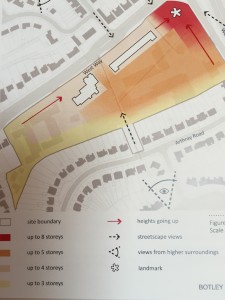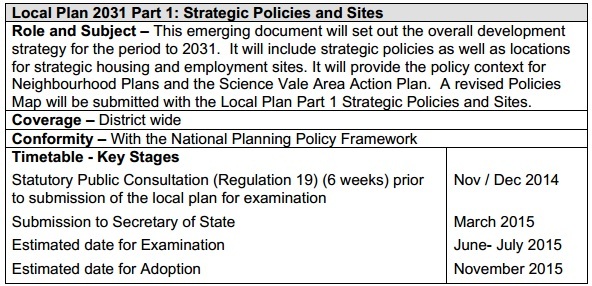The draft Botley SPD (Supplementary Planning Document) has been released for public consultation. Deadline for consultation is 16:30 on 25 Sep 2015.
This SPD, once adopted, will be a material consideration in the determination of all planning applications for the central area of Botley, most notably the anticipated Doric2 application coming in the autumn or winter this year.
Your views matter! Have a read, and send in your comments to the Vale via their website.
To see what the Vale says about what they have in mind for us in Botley, or to read or download the documents, see their website: http://bit.ly/1NOPGCb
The best way to keep up with everything happening is the West Way Concern website. Their shop at 5 Elms Parade has a hard copy so you can see it for yourself.
The photo at the top of this page is an artist’s representation of one possibility (it’s from the back inside cover of the SPD). However, do note this diagram to the right, showing 8 storeys at the easternmost end (pg 29).
Doric1 had this ‘landmark’ height in the same place, on the corner. But the architect’s panel who reviewed Doric1 plans, thought the tallest part of the development should be near the centre of the site, so it was moved. We’re back to the large 8 storeys at the corner of West Way and Westminster Way. To compare, the new block of flats at the corner of Arthray Rd and Westminster Way that you can see from the A34 is three storeys. Those living on the top floor overlook the A34.
I have some opinions, yes. Your opinion counts exactly the same as mine. Plus, I’m elected to represent what’s best for this community. Won’t you let me know what you think?
I look for appropriate size and style for the Botley context, evidence that supports the choices being made (eg, student accommodation and a multiplex cinema, nightclubs or bars), pedestrian flow from the south to the north for students and parents headed toward Botley school, preservation of the burial garden at Sts Peter’s and Paul’s church, quality replacement community facilities, and so on.
I also am concerned about this development within an AQMA, and also right up against the high levels of noise from the A34. Not only should this development not contribute to noise and air pollution (the SPD goes further and says redevelopment should lower pollution and carbon exhaust), it should protect future residents from the health effects of living in the polluted air and overwhelming noise from the A34.
So, what do you think?





